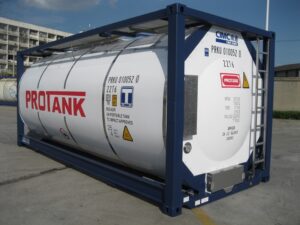Tanktainer is the name given for a tank container. Now, what is a tank container? Imagine a sturdy, rectangular metal frame that holds a stainless steel container inside, and you have the picture of a tank container or tanktainer.

The container that is held inside the frame is usually cylindrical or capsule-shaped and the frame holds it firmly in place to prevent rolling.
The frame of a tanktainer gives it the shape and dimensions of a standard shipping container making it easily transportable along with other normal intermodal containers. It allows MHE (Material Handling Equipment) to handle it just like any other GP container. As such, the tanktainer is classified as an intermodal container.
Typically, tank containers follow the dimensions of an ISO 20’ intermodal container, and each one is affixed with a valid CSC plate (Convention for Safe Containers). It is a small rectangular plate that shows the essential details of the equipment as prescribed by the Convention for Safe Containers (1972).
In its basic form, such a container will have a circular opening on its top, with a sealable hatch. This is used for filling the container or for access during cleaning. Filling may also be done through valves present on the container. The contents are usually emptied through valves that are located at the base of the container. Each tank can hold approximately 26,000 liters of liquid in it.
The stainless steel tanks of tanktainers normally have an outer insulative layer. A temperature gauge to monitor the temperature of the contents of the tank and a pressure relief valve (PRV) to control pressure build-up within the tank, especially when it carries liquid cargo, are standard on a tank container.
Read Also: LASWA Begins Water Safety, Swimming Lessons For Riverine Schools
For ease of access, the top part of the frame may be in the form of a platform with slots for opening the hatch or other such valves. Filling and emptying are carried out using special heavy-duty hoses and high-pressure pumps.
What are tanktainers used for?
Bulk powders, liquids, and gases that cannot be stored inside a standard shipping container are transported in tanktainers. These days, refrigerated as well as heated tank containers are used to transport certain hazardous as well as non-hazardous cargo. Such containers must conform to ISO and IMDG standards.
Examples of cargo transported thus are chemicals, fuels, liquid resins, edible oils, milk and dairy products, wines, gases, etc.
The tank of a tanktainer is made of stainless steel with a layer or layers of insulation material on its surface. The insulative layer is usually made of polyurethane and aluminium.
Large organizations such as oil, gas, or chemical companies own tanktainers to transport their goods. Tank containers are also available with most major container leasing companies.
Kindly like us on Facebook
















Discussion about this post